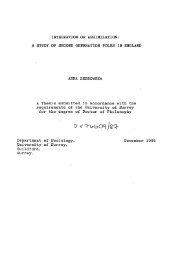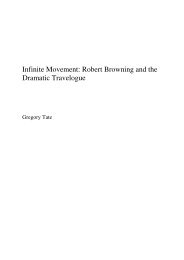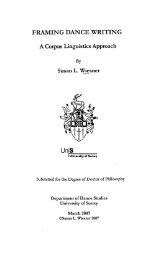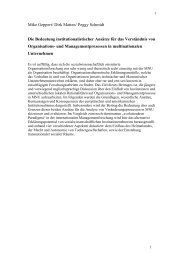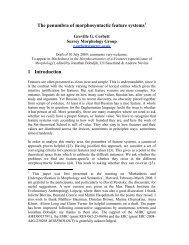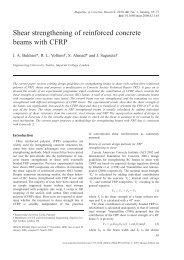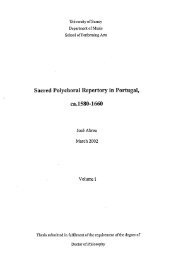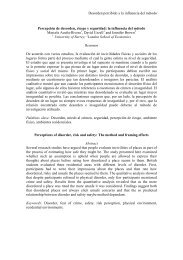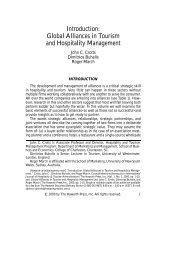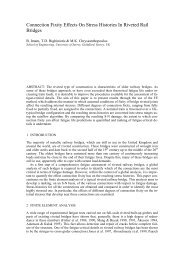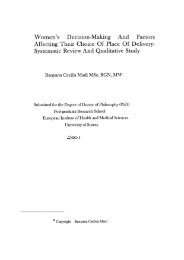Bart Rienties *, Wolter Kaper , Katrien Struyven , Dirk T. Tempelaar ...
Bart Rienties *, Wolter Kaper , Katrien Struyven , Dirk T. Tempelaar ...
Bart Rienties *, Wolter Kaper , Katrien Struyven , Dirk T. Tempelaar ...
You also want an ePaper? Increase the reach of your titles
YUMPU automatically turns print PDFs into web optimized ePapers that Google loves.
Draft paper:<br />
Full paper published at: http://www.tandfonline.com/doi/abs/10.1080/10494820.2010.542757<br />
Please cite as:<br />
<strong>Rienties</strong>, B., <strong>Kaper</strong>, W., <strong>Struyven</strong>, K., <strong>Tempelaar</strong>, D. T., Van Gastel, L., Vrancken, S., et al. (2011). A review of<br />
the role of Information Communication Technology and course design in transitional education practices.<br />
Interactive Learning Environments, 1-19.<br />
Author Posting. (c) 'Copyright Holder', 2011.<br />
This is the author's version of the work. It is posted here by permission of 'Copyright Holder' for personal<br />
use, not for redistribution.<br />
The definitive version was published in Interactive Learning Environments, , January 2011.<br />
doi:10.1080/10494820.2010.542757 (http://dx.doi.org/10.1080/10494820.2010.542757)<br />
<strong>Bart</strong> <strong>Rienties</strong> a, *, <strong>Wolter</strong> <strong>Kaper</strong> b , <strong>Katrien</strong> <strong>Struyven</strong> c , <strong>Dirk</strong> T. <strong>Tempelaar</strong> d , and<br />
Leendert van Gastel b , Sanne Vrancken c , Magdalena Jasi�ska e , Egl� Virgailait�-<br />
Me�kauskait� f ,<br />
a University of Surrey, United Kingdom; b Universiteit van Amsterdam, the Netherlands; c KU<br />
Leuven, Belgium; d Maastricht University, the Netherlands, e Maria Curie Sk�odowska<br />
University, Poland Poland; f Šiauliai University, Lithuania.<br />
Corresponding author. Email: b.rienties@surrey.ac.uk
A review of the role of ICT and course design in transitional education<br />
practices<br />
An increasing number of higher educational institutes are offering remedial, bridging, preparatory<br />
or transitional courses in a blended and online format to remediate and enhance students’<br />
knowledge and skills. This paper addresses how teachers and institutes design and implement<br />
these courses. The descriptions of transitional courses were collected by means of an online<br />
questionnaire and results were stored in a searchable online database. In the questionnaire<br />
consisting of 38 closed and open-ended questions, teachers had to indicate their content, context,<br />
organisation, pedagogical approach, assessment method and ICT use. During February-May 2009,<br />
118 course descriptions and implementations were collected. These 118 course descriptions were<br />
analysed with the aim of describing their main educational scenarios using multiple<br />
correspondence analysis and two-step clustering analysis. The results indicate that courses can be<br />
explained by five dimensions: 1) ICT; 2) Mathematics versus language; 3) Lower versus higher<br />
Bloom levels; 4) Gamma sciences versus others; and 5) Very small group size versus others.<br />
Afterwards, the courses were positioned into six distinctive clusters. An important finding of this<br />
study is that teachers seem to design and implement fairly similar course designs when content,<br />
context and pedagogical approach are given. Furthermore, teachers’ choices about ICT use are not<br />
yet systematically and consensually linked to content and pedagogical choices.<br />
Keywords: ICT; Course design; pedagogical approach, role of teacher; multi-method approach<br />
Introduction<br />
In an increasingly globalising world, businesses are looking for excellent graduates<br />
with international experience and state-of-the-art knowledge and skills (Van der Wende,<br />
2003). An increasing number of students is studying abroad in order to acquire international<br />
experience and to increase their attractiveness for international companies (<strong>Rienties</strong>,<br />
Grohnert, Kommers, Niemantsverdriet, & Nijhuis, 2011; <strong>Rienties</strong> & <strong>Tempelaar</strong>, 2009). For<br />
example, in Europe the number of students that are studying at a higher educational institute<br />
outside their home country has increased with 57% from 327.500 in 1998 to 515.400 in 2006<br />
(EUROSTAT, s.d.).<br />
This increased heterogeneity of enrolments in higher education has an unquestionable<br />
impact on transitional problems. Common transitional problem areas for students are found in<br />
mathematics, language, research methods or intercultural skills. In fact, there is a growing<br />
concern among educators and policy makers that learners – foreign and local – are not well-<br />
prepared to start a bachelor or master programme (Jindal-Snape, 2010).<br />
As a result, an increasing number of higher educational institutes is tackling these<br />
transitional problems by designing remedial courses, transitional courses, summer courses,
developmental courses or preparatory courses, to equip learners with required knowledge,<br />
skills and competences before entering a higher education programme (Attewell, Lavin,<br />
Domina, & Levey, 2006; Bettinger & Long, 2005; Brants & <strong>Struyven</strong>, 2009; Brouwer,<br />
Ekimova, Jasinska, Van Gastel, & Virgailaite-Meckauskaite, 2009; <strong>Rienties</strong>, <strong>Tempelaar</strong>, Van<br />
den Bossche, Gijselaers, & Segers, 2009; <strong>Tempelaar</strong>, <strong>Rienties</strong>, & Giesbers, 2009). Remedial<br />
education is a common approach to prepare students both academically and socially during<br />
the early stages of college and university (Attewell, et al., 2006; Bettinger & Long, 2005).<br />
Differences in cognitive demands, nature of tasks, self-regulation, the amount of self-study,<br />
and discovery learning required in higher education settings are pinpointed as causes for a<br />
need for transitional education (Conley, 2007; McCabe & Day, 1998).<br />
In the United States 98% of 2-year public colleges and 80% of public institutions<br />
offer at least one remedial course in reading, writing or mathematics (Attewell, et al., 2006;<br />
Boyer, Butner, & Smith, 2007; Kozeracki, 2002). Mathematics is the most common remedial<br />
subject, followed by reading and writing (Attewell, et al., 2006; Merisotis & Phipps, 2000).<br />
Regarding the context of remedial coursework, courses can be characterised as either<br />
embedded in the regular academic programme or separate from the programme; for example<br />
prior to a given programme in the form of summer schools (Brants & <strong>Struyven</strong>, 2009;<br />
Brouwer, et al., 2009; <strong>Rienties</strong>, <strong>Tempelaar</strong>, Dijkstra, Rehm, & Gijselaers, 2008; <strong>Rienties</strong>, et<br />
al., 2009; Roueche & Roueche, 1999; <strong>Tempelaar</strong>, et al., 2009).<br />
Remedial courses are not only organised in face-to-face settings. Often for practical<br />
reasons transitional courses are offered in an blended or distance format (Brants & <strong>Struyven</strong>,<br />
2009; <strong>Rienties</strong>, <strong>Tempelaar</strong>, Waterval, Rehm, & Gijselaers, 2006). Information<br />
Communication Technology (ICT) has powerful Web 2.0 tools that might benefit learners. In<br />
fact, ICT has gained the power to support independent learning as well as to learn irrespective<br />
of time and geographical constraints with the wide-spread implementation of Internet
(Bryant, Khale, & Schafer, 2005; Lou, Bernard, & Abrami, 2006; Resta & Laferrière, 2007;<br />
Wheeler, 2007). Using internet technologies, learners can follow individually tailored<br />
blended or distance courses such as mathematics (Brouwer, et al., 2009), statistics<br />
(<strong>Tempelaar</strong>, et al., 2009) or accounting (Bryant, et al., 2005) while being off-campus. This<br />
enhances the flexibility of learners to combine work, internship or holiday with study, which<br />
is of great value in transitional courses. Besides enriching independent learning experiences<br />
for learners, recently several powerful ICT tools and methods for learning in collaborative<br />
settings have been developed where learners work and learn together (Järvelä, Järvenoja, &<br />
Veermans, 2008; Jonassen & Kwon, 2001; Resta & Laferrière, 2007; Schellens, Van Keer,<br />
De Wever, & Valcke, 2009; Wang, 2009). Recent research on transitional education using<br />
ICT has highlighted that in particular the interactivity, adaptivity and possibilities of rapid<br />
feedback of ICT tools and interactive learning environments are important merits when<br />
students are not able to come to college or university or when students have large knowledge<br />
or skills gaps (Brants & <strong>Struyven</strong>, 2009; <strong>Rienties</strong>, et al., 2009; <strong>Rienties</strong>, et al., 2006;<br />
<strong>Tempelaar</strong>, et al., 2009; Wieland et al., 2007). However, according to Wang (2009, p. 1), the<br />
advantages of more student-centred, engaging and reflective interactive and collaborative<br />
learning environments “do not happen spontaneously unless the learning environments are<br />
thoughtfully designed”.<br />
The role of the teacher in creating and facilitating an interactive learning environment<br />
is widely acknowledged as being one of the core elements of successful blended and online<br />
learning (De Laat, Lally, Lipponen, & Simons, 2007; Löfström & Nevgi, 2008; Mazzolini &<br />
Maddison, 2003). Several researchers (Garrison, Anderson, & Archer, 1999; Järvelä &<br />
Häkkinen, 2002; Kirschner, Strijbos, Kreijns, & Beers, 2004; Koehler & Mishra, 2005;<br />
Mishra & Koehler, 2006; Resta & Laferrière, 2007) have addressed that an effective<br />
educational design using ICT should involve cognitive, pedagogical, social and technological
elements. In a range of studies on effective blended and online course designs, Mishra and<br />
Koehler (2006) found that teachers should carefully balance and integrate their cognitive,<br />
pedagogical and technological knowledge when designing and teaching blended or online<br />
courses. In a study among 27 novice teachers who followed an e-learning training program,<br />
Löfström and Nevgi (2008) indicate that the pedagogical awareness of these teachers with<br />
respect to ICT was well-established. However, in many courses that are adjusted into blended<br />
or online settings teachers commonly add an ICT tool or use an ICT tool with a particular<br />
purpose without adjusting the cognitive content and/or pedagogical approach of the course<br />
(Mishra & Koehler, 2006; Resta & Laferrière, 2007). As a result, the learning experience of<br />
students following the online version of the course might be less rich than students following<br />
a face-to-face course (Järvelä, et al., 2008; Jonassen & Kwon, 2001).<br />
In a review of 20 years of Computer-Supported Collaborative Learning research, Resta<br />
and Laferrière (2007, p. 76) recommend that “research is needed on the organisational issues<br />
related to implement CSCL in higher education to determine the essential conditions that<br />
must be in place for effective faculty use of CSCL”. Furthermore, given the complex nature<br />
of blended and online learning, several researchers (De Laat, et al., 2007; Hurme, Palonen, &<br />
Järvelä, 2007; Järvelä, et al., 2008) recommend to analyse effective course designs using an<br />
integrated multi-method approach. In line with these recommendations and the urge of Resta<br />
and Laferrière (2007) and others to assess the role of ICT in real-world educational settings,<br />
this paper addresses how teachers design and implement interactive learning environments<br />
using ICT in face-to-face, blended and distance education. In particular, we will review the<br />
design and implementation of cognitive, pedagogical, social, organisational and technological<br />
course elements in 118 transitional courses using a multi-method approach. The research<br />
questions are:<br />
(1) What are the main dimensions along which transitional courses differ from each other?
(2) What constellations of content, context, organisation, pedagogical approach, assessment,<br />
ICT usage often co-occur and can therefore be considered tested or ‘good’ practices?<br />
Methods<br />
Sample and data collection<br />
An online questionnaire was built based upon an extensive literature review (Brants &<br />
<strong>Struyven</strong>, 2009), needs-analysis and experience from several projects on transitional<br />
education (<strong>Rienties</strong>, et al., 2008; <strong>Rienties</strong>, et al., 2006). The six key factors of transitional<br />
education (content, context, organisation, pedagogical approach, assessment, ICT usage)<br />
were integrated into a questionnaire of 38 open and closed questions. The questionnaire was<br />
distributed via the EARLI (EARLI, 2009a, 2009b) and EDINEB network i to teachers,<br />
designers and organizers of transitional courses, with an open invitation to share their course<br />
designs. A total of 118 transitional courses reported by 84 respondents from 65 institutions<br />
and from 22 countries were gathered in the period February-May 2009, whereby a distinction<br />
was made between face-to-face, blended and distance education settings. For each of the<br />
eight categories below there was an open field in which respondents could add explanations<br />
to their standardised answers. Furthermore, there were separate open fields for providing<br />
comments, and a rationale for the transitional activity as a whole.<br />
(1) Identification: country, organising institution, course name, name and email address of<br />
the respondent. Respondents could indicate whether they wanted their course design to be<br />
publicly viewable on the web (75 out of 118 gave permission) ii .<br />
(2) Content: discipline and skills taught during the course, aim(s) of the course (reviving<br />
forgotten knowledge, learning new knowledge), flexibility of the course content.<br />
(3) Context: the scheduling of the transitional course relative to the regular higher education<br />
program was probed: is the course scheduled before the start of the program (e.g. summer<br />
course), or in parallel to it? In case of parallel scheduling, it was asked how the<br />
transitional activity was related or integrated with the regular program.<br />
(4) Organisation: who organises the course (university staff or a commercial party)?; was<br />
special funding available for developing and implementing the course?; do students pay<br />
for participation?; is attendance of the course obligatory?; what was the number of<br />
students attending the course?; is it distance, blended or face-to-face learning?<br />
(5) Pedagogical approach, including support: work-format (individual, collaborative, both),<br />
types of individual tasks (exercises, presentations, ...), types of group tasks (discussions,<br />
projects, ...), instructional support (teacher, peers, digital tutor, ...).
(6) Assessment: the timing (before, after, during the transitional activity), the purpose<br />
(formative, summative, both), the form (exam, essay, ...), the adaptivity of assessment<br />
was questioned. In addition, respondents were asked to indicate to what extent the<br />
assessment focussed on knowledge and skills.<br />
(7) ICT use: for a range of possible purposes respondents had to indicate whether ICT was<br />
used and for that purpose or not. Furthermore, a collection of ICT tools was presented,<br />
with checkboxes to indicate whether these tools were used.<br />
(8) Evaluation: there was one open text field in which respondents could share their<br />
evaluation of the course. Respondents were left free to either give personal impressions,<br />
cite formal evaluation results such as documents of evidence or providing references to<br />
publications.<br />
Data analysis<br />
The data were analysed using a multi-method approach. First of all, a Multiple<br />
Correspondence Analysis (MCA) was used to provide an answer to the first research<br />
question: to find the most important dimensions on which transitional courses in our database<br />
distinguish. MCA is the categorical data analogue of factor analysis or principle component<br />
analysis for quantitative data. MCA determines the independent dimensions that explain most<br />
of the variation in the dataset. Like in factor analysis, these dimensions are constructed to be<br />
independent, are characterised by a decreasing contribution in the explanation of total<br />
variation, and an eigenvalue criterion is used to decide on the number of dimensions. MCA<br />
takes its name from the fact that it portrays the correspondence of categories of variables.<br />
To elaborate the second research question as to which constellations of content,<br />
context, organisation, pedagogical approach, assessment, and ICT usage often co-occur,<br />
cluster analysis was applied. Of the three general approaches to cluster analysis, hierarchical,<br />
K-means, and two-step clustering, the last approach is most suited for categorical data.<br />
Therefore, we applied two-step clustering to assign all courses to clusters based on similarity,<br />
with Schwarz's Bayesian criterion (BIC) as the clustering criterion, and log-likelihood as the<br />
distance measure. The clustering could have been applied to the raw data, but anticipating<br />
the results of the MCA, that provide evidence that a substantial part of the variation in the<br />
data is adequately expressed by using only five independent dimensions instead of the
original 68 variables, a two-step clustering procedure, where the clustering takes place with<br />
regard to the dimensions produced by the MCA, was regarded as most appropriate.<br />
Finally, a content analysis was conducted on the eight category evaluation as well as<br />
other open text fields. First of all, three general approaches were brought forward by the<br />
respondents in order to provide evidence of the effectiveness of their course design and<br />
implementation (i.e. students’ response based upon evaluation questionnaire or interview,<br />
respondent’s opinion, proof of effect of intervention in form of data or publication). This<br />
investigation started from the assumption that respondents would by and large report<br />
transitional practices that they were proud of and satisfied with. It was not to be expected that<br />
an equally good sample of negatively evaluated courses would be obtained. Therefore, our<br />
idea was to regard all clusters found as good practices, until the opposite is proved. In total 21<br />
course descriptions included students’ responses, 21 course descriptions included the<br />
respondent’s or teacher’s opinion, 36 course descriptions included multiple opinions from<br />
stakeholders (students, teachers, management, etc.) and 4 were uncodeable. Afterwards, all<br />
evidence provided by the respondents to proof their good practice was categorised on a 4-<br />
point scale (negative, moderately negative, moderately positive, positive) by an independent<br />
coder who is a trained educational psychologist. For each of the clusters we checked if being<br />
a member of that cluster correlated with course evaluation. In addition, for each of the MCA<br />
dimensions we checked the correlation with course evaluation using Spearman’s rho<br />
correlation.<br />
Results<br />
Descriptive statistics of purpose of ICT usage<br />
In Table 1, the purpose of usage of ICT in face-to-face, blended and distance transitional<br />
education is illustrated. On average, in transitional face-to-face education ICT is used for 2.6<br />
purposes, whereby standard deviations in Table 1 are illustrated in brackets. In the 46 face-to-
face education courses in our database, ICT is primarily used for storage (e.g. course<br />
materials, lecture materials) and communication with students (e.g. announcements, emails).<br />
In total 4 respondents indicated not to have used ICT in their face-to-face education. In total<br />
47 courses are identified by respondents as blended education, where part of the educational<br />
experience of students takes place outside the class-room. On average, ICT is used for 5.8<br />
purposes in blended transitional courses ICT is primarily used for communication, storage,<br />
submitting (i.e. assignments), web-searches and collaboration (with peer-students and<br />
teacher). Finally, 26 course descriptions are identified by respondents as distance education,<br />
whereby on average ICT is used for 6.3 purposes. In the majority of transitional courses in<br />
distance education ICT is intensively used for storage, assessment, feedback after tests<br />
communication, submitting and tests. Except for ICT for presentations and ICT for other<br />
purposes, significant differences are found between the three forms of education using a Chi-<br />
Square test as is shown in Table 1. In general, when transitional education is designed in a<br />
distance-learning format, ICT is used for more purposes than blended and face-to-face<br />
education and the role of ICT in assessment and feedback is considerably more important.<br />
----------<br />
Insert Table 1 about here<br />
-----------<br />
Dimensions for describing transitional teaching practices<br />
Although Table 1 indicates that teachers have different purposes for ICT usage when courses<br />
are taught in face-to-face, blended or distance education, a more complex analysis is needed<br />
in order to distinguish the cognitive, pedagogical, social, organisational and technological<br />
elements in the course design and implementation. Therefore, a Multiple Correspondence<br />
Analysis (MCA) was conducted on the 118 transitional courses. The MCA resulted in a five-<br />
dimensions solution that explained 47% of variation of our data. The decision to ignore
higher dimensions was based on Cronbach's alpha (0.73 for dimension 6, and lower for the<br />
higher ones), as well as on the result that total explained variation is only slowly increasing<br />
for dimensions higher than five (about 4% extra explained variation for each added<br />
dimension). The dimensions found were interpreted by reviewing the variables that correlate<br />
highly or exclusively with each of the dimensions, and by checking significance of<br />
correlations (chi-square test, P < 0.05) between such variables (Michailidis & De Leeuw,<br />
1998). In the cluster analysis, the optimal number of clusters was found to be four. However,<br />
one of these four clusters had an unclear profile and contained half the courses in our sample.<br />
Therefore, a clustering into 5 and 6 clusters was forced. The quality of the obtained clusters<br />
was checked by plotting the clusters in the first two dimensions as revealed by MCA and<br />
requiring that clusters have clear boundaries in the MCA picture (See Michailidis & De<br />
Leeuw, 1998). Using that same criterion, a clustering into seven or more clusters was<br />
rejected. The five dimensions that are characterised with decreasing contribution to variance<br />
(V) from the MCA can be interpreted as follows:<br />
(1) ICT: less versus more ICT (V = 15%). From the 68 variables in our questionnaire, 30 can<br />
be a priori classified as being about ICT. From these, 25 have their main component<br />
along this dimension. Reversing the argument: there are 11 variables that point "almost<br />
purely" along this dimension (the next component is at least a factor 3 smaller) and all of<br />
those are about use of ICT. We conclude that this dimension measures use of ICT: on one<br />
side are 37 courses that use little ICT tools and 4 courses that use no ICT tools in their<br />
education and primarily use traditional face-to-face education tools like paper and pencil.<br />
On the other side there are 58 courses that intensively use ICT tools, in the middle are 19<br />
courses that integrate ICT tools with face-to-face education tools, as was found in Table<br />
1.<br />
(2) Mathematics versus language (V = 11%). This dimension is related to the content and the<br />
pedagogical approach of courses: 22 Mathematics courses are at the negative end of this<br />
scale, 57 courses teaching a specific language are at the positive end, while 39 courses are<br />
located in the middle. This finding is in line with research on remedial education,<br />
whereby mostly mathematics, language and writing courses are given (Attewell, et al.,<br />
2006; Brants & <strong>Struyven</strong>, 2009; <strong>Rienties</strong>, et al., 2008). This content aspect correlates with<br />
a number of didactical decisions: the negative half of the scale correlates with<br />
individualised pedagogical approaches, individualised course content, and distance<br />
learning. The positive half correlates with work forms involving collaboration, course<br />
content differentiated according to subgroup, non-distance learning. One organisational<br />
variable plays a role: courses on the negative half of the scale more often have funding.
(3) Bloom levels: lower versus higher (V = 9%). 11 courses are positioned on the negative<br />
half of this axis tend to have: assessment focused on knowledge; exercises done<br />
individually; content is adapted for subgroups; assessment is done for summative<br />
purposes; and a commercial institute (instead of a higher educational institute) is often<br />
organising such a course. These courses possibly aim at realising higher educational<br />
institute entrance requirements in a short time. Therefore, they are more often scheduled<br />
before the regular higher educational program. At the middle of the scale are 41 higher<br />
educational institute-organised courses that are less focused on knowledge, less individual<br />
exercises, content is not adapted to subgroups, scheduling is more often during the regular<br />
study program and assessment is less often summative. Finally, 66 courses on the positive<br />
half of this axis tend to be positioned in the regular study program. We might interpret<br />
that these courses have less time restrictions and therefore more freedom in choosing<br />
work formats that cater also to the higher Bloom levels (Bloom, Englehart, Furst, Hill, &<br />
Krathwohl, 1956).<br />
(4) Gamma sciences versus others (V = 7%). This dimension separates the social-, business<br />
and managerial sciences from the other disciplines: the 9 gamma science courses are on<br />
the positive side of the scale, 109 courses that are characterised as “other sciences” have<br />
their centre of gravity on the negative side. Courses at the positive half of the scale have<br />
assessments focusing less often on skills.<br />
(5) Group size: very small versus others (V = 5%). This dimension separates a relatively<br />
small number of 17 courses far on one side of the scale, while the majority is close to the<br />
origin. The isolated small group has: very small group size (1-10 participants),<br />
collaborative work form, the transitional activity is optional and scheduled in parallel to<br />
the regular course that needs the skills, and assessment is less often done for formative<br />
reasons.<br />
These results show that content or discipline taught is not a one-dimensional concept:<br />
two of the five dimensions (dimensions 2 and 4) found are strongly related to content. This is<br />
to be expected: why would mathematics, languages and gamma sciences fit to one<br />
dimension? In the same way: pedagogy appears not to be a one-dimensional concept, with<br />
pedagogical choices showing up in three of the five dimensions (dimensions 2, 3 and 5).<br />
Dimension "2. Mathematics versus language" shows many educational design choices<br />
correlating with the content aspect of this dimension.<br />
Seeing that both content and pedagogy appear as multi-dimensional, it may come as a<br />
surprise that ICT-use appears as only one dimension: relatively many ICT related variables<br />
correlate with each other, using ICT for purpose X increases the likelihood of also using it for<br />
Y. However, ICT-related variables in general are not playing a prominent role in other<br />
dimensions than the first. The notable exceptions (r > 0.3 on other dimensions) are: the
choice between distance learning, blended and face-to-face (dimensions 1 and 2), and the use<br />
of assessment in the form of a digital exam (stronger on dimension 2 than on 1), which was<br />
also found in the previous section.<br />
The five dimensions presented above are ordered according to their decreasing<br />
contribution to the explained variation in our dataset. However, this ordering in itself is not to<br />
be viewed as a result, because it is in large part an artefact of the questions asked. For<br />
instance, the fact that the dimension "1. ICT, less versus more" explains the largest part of the<br />
variation reflects the number of questions asked about ICT, therefore reflects our research<br />
interests rather than being a result. The above observation about the ICT-variables mainly<br />
correlating among themselves, in contrast, is to be regarded as a result, because each of these<br />
ICT variables had the potential to correlate with e.g. each of the pedagogic variables, but only<br />
few of them did show such a correlation.<br />
Six clusters of transitional courses portrayed<br />
Our multi-method approach directed at understanding the design and implementation of<br />
interactive learning environments has two-step clustering (BIC) as the second tool. By the<br />
method described we arrived at a six cluster solution. In order to integrate both methods, we<br />
will interpret the six clusters in terms of their scores on the MCA dimensions. We will use the<br />
first four dimensions found by MCA to give an insightful presentation of differences between<br />
the clusters. The fifth dimension does not show a clear separation between any of the 6<br />
clusters found. When we label all the courses with their cluster-number and afterwards plot<br />
all courses in the first two dimensions as revealed by MCA, the result is as in Figure 1. From<br />
Figure 1 we conclude that each of the clusters occupies its own region, with only limited<br />
overlap at the boundaries. This implies that teachers design fairly similar courses in a<br />
particular context, which depends on the course content (mathematics, language) and learning<br />
setting (face-to-face, blended, distance).
-----<br />
Insert Figure 1 about here<br />
-----<br />
The number of courses in each cluster, as well as the number of countries involved, is shown<br />
in Table 2. Furthermore, in Figure 2, typical values for variables that turned out strong<br />
discriminators (r > 0.4 with one dimension or > 0.3 with two or more dimensions) during<br />
MCA for each of the clusters are given. In Figure 2, the clusters are again spread out in<br />
MCA-dimensions 1 and 2 (ICT and Mathematics vs. language), and those variables strongly<br />
related to these dimensions are highlighted, while the others (strongly related to dimension 3,<br />
4 or 5, but not to 1 or 2) are shown in grey. For example, for cluster 6 lower right this implies<br />
that ICT is distinctively and intensively used in a collaborative distance setting for business<br />
education along dimension 1 and 2. Furthermore, the assessment of this cluster of courses is<br />
on individual knowledge exercises at a lower Bloom taxonomy dimension 3, while the<br />
assessment it not focussed on skills along the gamma science dimension 4.<br />
------<br />
Insert Table 2 about here<br />
------<br />
The six clusters found can now be characterised as follows, using as names their place<br />
in the MCA-dimensions 1 and 2 with respect to the origin (in clockwise order):<br />
------<br />
Insert Figure 2 about here<br />
------<br />
(3) Left. These 30 courses have in common that they use little or no ICT. Face-to-face<br />
teaching is the only teaching method. Furthermore, collaborative work is used relatively<br />
often. Finally, in 14 courses there is no assessment, which is unique to this cluster:<br />
outside this cluster all courses have assessment in one form or another. With respect to<br />
content, this cluster is mixed.<br />
(5) Upper left. These 11 courses all originated from one author from one institution. Like the<br />
previous cluster, ICT is not used intensively and teaching occurs face-to-face. Half of<br />
these courses focus on learning a language, the other half focus on other discipline<br />
specific skills. The pedagogical approach is equally often collaborative as individual. The
courses are organised by a commercial party, have a small group size (11-20), exercises<br />
are done individually and assessments focus on knowledge.<br />
(1) Near upper right. These 36 courses use ICT for various purposes but not for assessment,<br />
which is why they appear in the middle of dimension "1. ICT: less versus more". They are<br />
on the language-half of dimension "2. Mathematics versus language". However, these<br />
courses are not about language but about academic skills. Like most language courses<br />
teachers have designed their courses in an equal mix of collaborative and individual work<br />
using blended learning.<br />
(4) Far upper right. These 10 courses use ICT for almost all possible purposes and teachers<br />
in these courses use ICT tools whose use is rare in other clusters. Half of these courses are<br />
language courses, the other half of the courses are other discipline specific skills.<br />
Teachers in this cluster use blended learning and their pedagogy is more often<br />
collaborative. Assessment focuses on skills. In half of these courses, a commercial party<br />
organises the course.<br />
(6) Lower right. These 9 courses are from four teachers in one institution. These teachers use<br />
ICT for assessment as well as for collaboration, which places them on the right half of the<br />
ICT-dimension. The courses are on the mathematics half of dimension "2. Mathematics<br />
versus language", but the content is gamma sciences: they share with most mathematics<br />
courses the use of distance learning, exercises are done individually, and assessments<br />
focus on knowledge. A difference with the cluster 2 of mathematics courses is the<br />
emphasis on collaborative work.<br />
(2) Down. These 22 courses are in large majority about mathematics. Most teachers in this<br />
cluster use distance learning, have flexible content adapted to the individual and use a<br />
self-directed learning approach. Furthermore, assistance and feedback is often provided<br />
by an online tool instead of a teacher, and the assessment focuses on knowledge. ICT is<br />
important for this group of courses but it is used for a limited number of purposes.<br />
Finally, the number of different ICT tools used is limited, making them earn a place in the<br />
middle of the ICT-dimension.<br />
From the clustering it becomes obvious that there's some granularity in our data:<br />
sometimes courses share a design because they originate from one institution, or even from<br />
one author. Two such single-institution clusters were found (clusters 5 and 6). Finding such<br />
clusters was not our priority, but on the other hand, separating them off helped in giving the<br />
remaining clusters a clearer profile.<br />
The same six clusters can also be pictured in the higher MCA-dimensions 3, 4 and 5.<br />
In Figure 3, the distinguishing variables for the dimension "3. Lower versus higher Bloom<br />
levels" are highlighted. Three of the six clusters are on the lower side of this dimension. Two<br />
of those three clusters are relatively close to the origin: their course designs contain more<br />
individual exercises and assessment focuses on knowledge rather than skills. The third
cluster, being positioned further down on that same side, also has a small group size, content<br />
differentiated according to subgroups, and a commercial party organising the course.<br />
------<br />
Insert Figure 3 about here<br />
-----<br />
In Figure 4 the distinguishing variables for the dimension "4. Gamma sciences versus<br />
others" are highlighted. One cluster of nine courses singles itself out on the gamma side of<br />
the scale: it has assessments that focus less often on skills. One other cluster singles itself out<br />
at the other side of the scale, but stays relatively close to the origin: it has assessments that<br />
focus more often on skills. The other four clusters have near-neutral positions on dimension<br />
4. Finally, with regard to the dimension "5. very small courses versus others" we found that<br />
none of our six clusters singles itself out on either side of this dimension.<br />
--------<br />
Insert Figure 4 about here<br />
--------<br />
Evaluation results<br />
As a third and last part of our multi-method approach, we conducted a content analysis on the<br />
open parts of the questionnaire. Content analysis of submitted course evaluations and various<br />
other text fields in our questionnaire indicates that authors of submitted course descriptions in<br />
large majority evaluated their courses positively, with only 9 out of 82 evaluations being<br />
negative (Table 4). The data and arguments mentioned to support these evaluations vary<br />
widely in kind and quality. The nine negative evaluations were unequally distributed over the<br />
six clusters of courses (Table 3): six of those nine negative evaluations occurred in cluster "3.<br />
Left", the cluster that had little or no ICT and often no assessment, while cluster "5. Upper<br />
left" has a higher than average number of positive evaluations.<br />
----------<br />
Insert Table 3 about here<br />
-----------
Cluster 5 is a small cluster, where all courses having been submitted by a single<br />
author, who consistently evaluated the submitted courses as positive. Cluster 3 is a large<br />
cluster with 30 courses from 13 countries and many different authors. For 18 of these courses<br />
evaluations are known: one third of these is negative, while two third is positive. From the<br />
other clusters (1, 2, 4, 5 and 6), none has more than one negative evaluation and this amounts<br />
to a maximum of 11% per cluster. As a conclusion we may state that all six clusters can be<br />
considered as “good” practices, however for courses in cluster 3 with some more reservations<br />
than for the other clusters.<br />
Table 4 shows the correlations of course evaluation with each of the five dimensions<br />
as revealed by MCA. Two of the five dimensions correlate significantly with course<br />
evaluation. Evaluations are more often positive on the "language" side of dimension "2.<br />
Mathematics versus language" and on the "lower" side of dimension "3. Bloom levels: lower<br />
versus higher".<br />
-------<br />
Insert Table 4 about here<br />
-----<br />
These findings correspond with the high proportion of negative evaluations found in<br />
cluster "3. Left", because that cluster is wholly on the "academic" side of that dimension.<br />
Also, the fact that 14 of the 30 courses in this cluster have no assessment suggests why some<br />
of these transitional courses might be doing less well: it is likely that they ask too little<br />
commitment from their participants.<br />
Discussion<br />
The aim of this research was to address how teachers design and implement transitional<br />
courses using ICT and how teachers balance and integrate the various cognitive, pedagogical,<br />
social, organisational and technological course elements. In particular, we focused on
distilling these course elements in 118 educational scenarios used for transitional courses<br />
using a multi-method approach. By means of a multiple correspondence analysis it is possible<br />
to answer the first research question. Five dimensions that together catch the main differences<br />
between transitional practices are identified and interpreted. Those dimensions are in<br />
decreasing importance: 1) ICT: less versus more; 2) Mathematics versus language; 3) Lower<br />
versus higher Bloom levels; 4) Gamma sciences versus others; and 5) Very small group size<br />
versus others. Of all variation amongst the 68 variables included in the database, no less than<br />
47% could be explained by just five dimensions, which is remarkable given the heterogeneity<br />
of courses, cognitive contents, pedagogical approaches, ICT usages and the fact that<br />
contributions came from 65 institutions from 22 countries.<br />
Two of these dimensions (2 and 4) show strong relationships between content and<br />
pedagogical choice. Courses in mathematics are characterised with individualised work<br />
forms, individualised course content and distance learning. Courses teaching a specific<br />
language, on the contrary, are related to collaborative work forms, differentiated course<br />
content according to subgroup and face-to-face learning. As Crowe and Zand (2000) state,<br />
mathematics is inherently less verbal than other subjects and debate – and therefore<br />
collaboration – plays a lesser role in mathematic courses than in other domains. Language<br />
courses in se demand collaboration to a much greater extent than mathematics courses do,<br />
because speaking is an essential feature of learning a language. Two other dimensions show<br />
relations between organisational context and pedagogy (3 and 5). For example, in the fifth<br />
dimension there is a relationship between very small group size and a collaborative work<br />
form.<br />
Dimension (1) summarises the strong correspondence amongst the majority of ICT<br />
related variables, and the lack of correspondence of most of these with other aspects of<br />
courses. In other words, ICT appears to be a pure factor in our multiple correspondence
analysis, which implies that the choice on how to use ICT (purpose, choice of tools, intensity,<br />
etc.) in transitional education appears to be independent from other design decisions like<br />
pedagogical approach or cognitive content. This is our first and most important finding in this<br />
study. An explanation why ICT related variables show so little relationship with other type of<br />
variables is likely found in two supposed common causes: the teacher either love or hate ICT;<br />
and/or local circumstances provide (in)sufficient support for ICT. Nonetheless, the fact that<br />
most ICT related variables do not correspond with any of the content or pedagogical variables<br />
may be a cause of concern.<br />
Mishra and Koehler (2006) argue that teachers should integrate their usage of<br />
technology when designing the cognitive content and pedagogy of the course. However, our<br />
findings indicate that in practice teachers will combine all different types of choices for an<br />
ICT tool with the choice for a particular content (e.g. mathematics, language), pedagogical<br />
choice and learning setting (i.e. face-to-face, blended, distance) when delivering a transitional<br />
course. In other words, in contrast to the argumentation of Mishra and Koehler (2006) and<br />
other researchers that teachers are implementing ICT in their education depending on<br />
affordances of the tool, we find that ICT usage is not significantly related to pedagogical<br />
approach and content of a course. At the same time it is equally possible that each teacher has<br />
a pedagogical reasoning for using a certain ICT tool for a certain course. However, if this is<br />
the case, then the results of the course and ICT design implementations by teachers show<br />
little common patterns yet. In other words, there is little consensus on what tool to use in a<br />
given context. ICT-use now seems largely a matter of individual or institutional preference. If<br />
ICT continues to integrate with other aspects of education, then we expect the reasons for<br />
ICT-variables to correlate among each other to become less (less love/hate feelings, good<br />
support everywhere). At the same time, we expect the correlations of the ICT-variables with<br />
content and pedagogical variables to increase (indicating growing consensus about using tool
X in context Y). As a conclusion, the disappearance of a single "ICT"-dimension should<br />
probably be taken as a sign of growing integration of ICT.<br />
The six clusters found in the two-step clustering technique provide an answer to the<br />
second research question. These clusters show often-occurring combinations of content,<br />
educational decisions, use of ICT, and institutional context. Each cluster is to be regarded as a<br />
tested combination of design decisions, for given content and context. This is our second<br />
important finding. Teachers in different countries seem to design and implement fairly<br />
similar course designs when content, context and pedagogical approach are given.<br />
With this study we intended to address how teachers design and implement online and<br />
blended courses and how they combine content, context, organisation, pedagogical approach,<br />
assessment, ICT usage. Future research should address an in-depth qualitative approach to<br />
identify the success- and fail factors within each of the six clusters. For example, by using<br />
focus group discussions with the teachers within and across the six clusters, underlying<br />
design principles not included in our method can be uncovered. Finally, the validation of our<br />
descriptive framework needs to be addressed. The fact that the low-dimensional model<br />
consisting of only five dimensions is able to explain 47% of the total variation of the 68<br />
variables specifying the 118 educational scenarios indicates that our framework provides an<br />
adequate description of the main characteristics of relevant educational options. Furthermore,<br />
given that our dataset includes respondents from 65 institutes from 22 countries, this<br />
increases the validity of our findings that teachers design fairly similar courses when the topic<br />
and pedagogical approach are known without specifically linking it to the possibilities,<br />
purposes or affordances of ICT. Finally, the absorption of all ICT-related factors in one<br />
dimension that is independent of all non-ICT related factors also implies that design decision<br />
with regards to pedagogical approach, organisation, assessment, and so on appear to be stable<br />
constructs. In other words: both within a paper and pencil context, and a high-tech context,
similar design decision are taken by teachers offering transitional courses. Overall, our study<br />
contributed to the debate how teachers design and implement effective interactive learning<br />
environments, whereby the specific discipline (mathematics, social science, language) and<br />
pedagogical approach (collaborative, self-directed) seem to influence how teachers embed<br />
ICT tools in their education.<br />
Acknowledgments<br />
The authors would like to thank the EU LLP KA3 ICT funding the S.T.E.P. project<br />
(http://www.transitionalstep.eu/), which enabled this research project. This publication<br />
reflects the views only of the authors, and the European Commission cannot be held<br />
responsible for any use which may be made of the information contained therein. We would<br />
like to thank the two anonymous reviewers for their suggestions of improvement of this<br />
article.<br />
References<br />
Attewell, P., Lavin, D., Domina, T., & Levey, T. (2006). New Evidence on College<br />
Remediation. The Journal of Higher Education, 77(5), 886-924.<br />
Bettinger, E. P., & Long, B. T. (2005). Remediation at the community college: Student<br />
participation and outcomes. New Directions for Community Colleges, 2005(129), 17-<br />
26.<br />
Bloom, B. S., Englehart, M. D., Furst, E. J., Hill, W. H., & Krathwohl, D. R. (1956).<br />
Taxonomy of educational objectives: Handbook I: Cognitive domain. New York:<br />
David McKay.<br />
Boyer, P., Butner, B., & Smith, D. (2007). A portrait of remedial instruction: faculty<br />
workload and assessment techniques. Higher Education, 54(4), 605-613.<br />
Brants, L., & <strong>Struyven</strong>, K. (2009). Literature Review on Online Remedial Education: A<br />
European Perspective. Industry and Higher Education, 23(4), 269-276.<br />
Brouwer, N., Ekimova, L., Jasinska, M., Van Gastel, L., & Virgailaite-Meckauskaite, E.<br />
(2009). Enhancing mathematics by online assessments, two cases of remedial<br />
education considered. Industry and Higher Education, 23(4), 277-284.<br />
Bryant, S., Khale, J., & Schafer, B. (2005). Distance Education: A Review of the<br />
Contemporary Literature. Issues in Accounting Education, 20(3), 255-272.<br />
Conley, D. T. (2007). The Challenge of College Readiness. Educational Leadership, 64(7),<br />
23-29.<br />
Crowe, D., & Zand, H. (2000). Computers and undergraduate mathematics: I: setting the<br />
scene. Computers & Education, 35(2), 95-121.<br />
De Laat, M., Lally, V., Lipponen, L., & Simons, R.-J. (2007). Online teaching in networked<br />
learning communities: A multi-method approach to studying the role of the teacher.<br />
Instructional Science, 35(3), 257-286.
EARLI. (2009a). Earli Association News. Educational Research Review, 4(1), I-V.<br />
EARLI. (2009b). Earli Association News. Educational Research Review, 4(2), I-III.<br />
EUROSTAT. (s.d.). Mobility of students in Europe. Retrieved from<br />
http://epp.eurostat.ec.europa.eu/portal/page?_pageid=1996,39140985&_dad=portal&<br />
_schema=PORTAL&screen=detailref&language=en&product=REF_TB_education_tr<br />
aining&root=REF_TB_education_training/t_edtr/t_educ_indic/tps00064.<br />
Garrison, D., Anderson, T., & Archer, W. (1999). Critical inquiry in a text-based<br />
environment: Computer conferencing in higher education The Internet and Higher<br />
Education, 2(2), 87-105.<br />
Hurme, T., Palonen, T., & Järvelä, S. (2007). Metacognition in joint discussions: an analysis<br />
of the patterns of interaction and the metacognitive content of the networked<br />
discussions in mathematics. Metacognition and Learning, 1(2), 181-200.<br />
Järvelä, S., & Häkkinen, P. (2002). Web-based Cases in Teaching and Learning – the Quality<br />
of Discussions and a Stage of Perspective Taking in Asynchronous Communication<br />
Interactive Learning Environments, 10(1), 1-22.<br />
Järvelä, S., Järvenoja, H., & Veermans, M. (2008). Understanding the dynamics of<br />
motivation in socially shared learning. International Journal of Educational<br />
Research, 47(2), 122-135.<br />
Jindal-Snape, D. (2010). Educational transitions: Moving Stories from Around the World:<br />
Routledge.<br />
Jonassen, D. H., & Kwon, H. (2001). Communication patterns in computer mediated versus<br />
face-to-face group problem solving. Educational Technology Research and<br />
Development, 49(1), 35-51.<br />
Kirschner, P. A., Strijbos, J.-W., Kreijns, K., & Beers, P. (2004). Designing electronic<br />
collaborative learning environments. Educational Technology Research and<br />
Development, 52(3), 47-66.<br />
Koehler, M. J., & Mishra, P. (2005). Teachers learning technology by design. Journal of<br />
Computing in Teacher Education, 21(3), 94-102.<br />
Kozeracki, C. (2002). Issues in Developmental Education. Community College Review, 29(4),<br />
83-100.<br />
Löfström, E., & Nevgi, A. (2008). University teaching staffs' pedagogical awareness<br />
displayed through ICT-facilitated teaching. Interactive Learning Environments, 16(2),<br />
101-116.<br />
Lou, Y., Bernard, R., & Abrami, P. (2006). Media and Pedagogy in Undergraduate Distance<br />
Education: A Theory-Based Meta-Analysis of Empirical Literature. Educational<br />
Technology Research and Development, 54(2), 141-176.<br />
Mazzolini, M., & Maddison, S. (2003). Sage, guide or ghost? The effect of instructor<br />
intervention on student participation in online discussion forums. Computers &<br />
Education, 40(3), 237-253.<br />
McCabe, R. H., & Day, P. R. (1998). What works in development education. In R. H.<br />
McCabe & P. R. Day (Eds.), Developmental education: A twenty-first century social<br />
and economic imperative. (pp. 19-26). Mission Viejo, CA: League for Innovation in<br />
the Community College.<br />
Merisotis, J. P., & Phipps, R. A. (2000). Remedial Education in Colleges and Universities:<br />
What's Really Going On? The Review of Higher Education, 24(67-85).<br />
Michailidis, G., & De Leeuw, J. (1998). The Gifi System of Descriptive Multivariate<br />
Analysis. Statistical Science, 13(4), 307-336.<br />
Mishra, P., & Koehler, M. J. (2006). Technological Pedagogical Content Knowledge: A<br />
Framework for Teacher Knowledge. Teachers College Record, 108(6), 1017-1054.
Resta, P., & Laferrière, T. (2007). Technology in Support of Collaborative Learning.<br />
Educational Psychology Review, 19(1), 65-83.<br />
<strong>Rienties</strong>, B., Grohnert, T., Kommers, P., Niemantsverdriet, S., & Nijhuis, J. (2011).<br />
Academic and social integration of international and local students at five business<br />
schools, a cross-institutional comparison. In P. Van den Bossche, W. H. Gijselaers &<br />
R. G. Milter (Eds.), Building Learning Experiences in a Changing World (Vol. 3, pp.<br />
121-137). The Netherlands: Springer Netherlands.<br />
<strong>Rienties</strong>, B., & <strong>Tempelaar</strong>, D. T. (2009). Mobility of lifelong learners and IT: Introduction to<br />
Special Issue. Industry and Higher Education, 23(4), 265-268.<br />
<strong>Rienties</strong>, B., <strong>Tempelaar</strong>, D. T., Dijkstra, J., Rehm, M., & Gijselaers, W. H. (2008).<br />
Longitudinal study of online remedial education effects. In N. P. Barsky, M.<br />
Clements, J. Ravn & K. Smith (Eds.), Advances in Business Education and Training<br />
1: The Power of Technology for Learning (pp. 43-59). Dordrecht: Springer.<br />
<strong>Rienties</strong>, B., <strong>Tempelaar</strong>, D. T., Van den Bossche, P., Gijselaers, W. H., & Segers, M. (2009).<br />
The role of academic motivation in Computer-Supported Collaborative Learning.<br />
Computers in Human Behavior, 25(6), 1195-1206.<br />
<strong>Rienties</strong>, B., <strong>Tempelaar</strong>, D. T., Waterval, D., Rehm, M., & Gijselaers, W. H. (2006).<br />
Remedial online teaching on a summer course. Industry and Higher Education, 20(5),<br />
327-336.<br />
Roueche, J., & Roueche, S. (1999). High stakes, high performance: making remedial<br />
education work. Washington DC: Community College Press.<br />
Schellens, T., Van Keer, H., De Wever, B., & Valcke, M. (2009). Tagging thinking types in<br />
asynchronous discussion groups: effects on critical thinking. Interactive Learning<br />
Environments, 17(1), 77-94.<br />
<strong>Tempelaar</strong>, D. T., <strong>Rienties</strong>, B., & Giesbers, B. (2009). Who profits most from blended<br />
learning? Industry and Higher Education, 23(4), 285-292.<br />
Van der Wende, M. C. (2003). Globalisation and Access to Higher Education. Journal of<br />
Studies in International Education, 7(2), 193-206.<br />
Wang, Q. (2009). Designing a web-based constructivist learning environment. Interactive<br />
Learning Environments, 17(1), 1 - 13.<br />
Wheeler, S. (2007). The influence of communication technologies and approaches to study<br />
on transactional distance in blended learning. ALT-J, 15, 103-117.<br />
Wieland, A., Brouwer, N., <strong>Kaper</strong>, W., Heck, A., <strong>Tempelaar</strong>, D. T., <strong>Rienties</strong>, B., et al. (2007).<br />
Factoren die een rol spelen bij de ontwikkeling van remediërend onderwijs. Tijdschrift<br />
voor Hoger Onderwijs, 1, 2-15.
Table 1. Purpose of ICT usage in face-to-face, blended and distance education.<br />
ICT usage in course (in %)<br />
Table 2. Sizes and names for the six clusters found.<br />
Cluster N % of Total Countries Remarks<br />
1. near upper right 36 30.50 11<br />
2. downward peninsula 22 18.60 6<br />
3. left 30 25.40 13<br />
4. far upper right archipel 10 8.50 5<br />
5. upper left island 11 9.30 1 1 institution, 1 author<br />
6. lower right two islands 9 7.60 1 1 institution, 4 authors<br />
Table 3. Correlation of evaluation with cluster membership as a yes/no variable.<br />
Cluster Unknown Positive<br />
Moderately<br />
Positive<br />
Moderatly<br />
negative Negative Total<br />
Spearman<br />
Correlation<br />
coefficient<br />
1. near upper right 15 14 6 1 0 36 -0.15<br />
2. downward peninsula 4 9 9 0 0 22 -0.01<br />
3. left 12 4 8 5 1 30 0.40**<br />
4. far upper right<br />
archipel 4 2 3 1 0 10 0.12<br />
5. upper left island 0 11 0 0 0 11 -0.35**<br />
6. lower right two<br />
islands 1 5 2 0 1 9 -0.03<br />
Total 36 45 28 7 2 118<br />
** Significant, P < 0.01 (2-tailed).<br />
Face-to-Face<br />
(n=46)<br />
Blended<br />
(n=47)<br />
Distance<br />
(n=26) Chi-Square<br />
ICT for Storage 43.5 72.3 84.6 14.599**<br />
ICT for Communication 41.3 83.0 73.1 18.700**<br />
ICT for Collaboration 30.4 59.6 50.0 8.133*<br />
ICT for Websearches 28.3 68.1 46.2 14.815**<br />
ICT for Presentations 26.1 38.3 19.2 3.331<br />
ICT for Submitting 23.9 68.1 61.5 20.048**<br />
ICT for Webimages 19.6 46.8 34.6 7.747*<br />
ICT for Feedback after tests 17.4 46.8 76.9 24.896**<br />
ICT for Assessment 13.0 40.4 80.8 32.233**<br />
ICT for Tests 8.7 36.2 57.7 20.189**<br />
ICT for Simulations 6.5 21.3 38.5 11.057**<br />
ICT for Other 4.3 8.5 7.7 0.692<br />
Total ICT purposes 2.6 (3.0) 5.8 (3.0) 6.3 (2.6) 61.384**<br />
** Pearson Chi-Square 2-sided significant at 0.01<br />
* Pearson Chi-Square 2-sided significant at 0.05
Table 4. Positive evaluation as a function of the five dimensions.<br />
Dimension Spearman<br />
Correlation<br />
Direction of effect:<br />
more positive on<br />
1. ICT, less -- more 0.09<br />
2. Mathematics -- language 0.23* "language" side<br />
3. Bloom level: no nonsense --<br />
academic 0.38** "no nonsense" side<br />
4. Gamma sciences versus others -0.05<br />
5. Group sizes: very small versus<br />
others 0.20 ("others")<br />
** Significant, P < 0.01 (2-tailed).<br />
*Significant, P < 0.05 (2-tailed).<br />
Figure 1. 118 courses plotted in MCA dimensions 1 and 2 (labelled by cluster).
Figure 2. All clusters pictured in MCA dimensions 1 and 2 (properties relevant to other<br />
dimensions are greyed out).<br />
Dimension 2.<br />
Language<br />
Dimension 2.<br />
Mathematics<br />
5. Upper left: 11 courses<br />
- content: language, or other<br />
discipline specific skills<br />
- equally collaborative / individual<br />
- face to face<br />
- no ICT<br />
- flexible content: subgroups<br />
- individual exercises<br />
- assessment focus on knowledge<br />
- small group size: 11-20<br />
- commercial party<br />
3. Left: 30 courses<br />
- content: mixed<br />
- collaborative work<br />
- face to face<br />
- no ICT<br />
- flexible content: no<br />
- no assessment<br />
Dimension 1. ICT: less<br />
1. Near upper right: 36 courses<br />
- content: academic skills<br />
- equally collaborative / individual<br />
- blended learning<br />
- ICT used but not for assessment<br />
- flexible content: no<br />
2. Down: 22 courses<br />
- content: mathematics<br />
- individual work<br />
- distance learning<br />
- ICT for assessment<br />
- ICT for feedback after test<br />
- flexible content: individually<br />
- flexible help by online tool<br />
- tasks individually done online<br />
- individual exercises<br />
- assessment focus knowledge<br />
Figure 3. Clusters properties pictured in MCA dimensions 2 and 3.<br />
Dimension 3.<br />
Bloom level:<br />
higher<br />
Dimension 3.<br />
Bloom level:<br />
lower<br />
2.: 22 courses<br />
- content: mathematics<br />
- individual work<br />
- distance learning<br />
- ICT for assessment<br />
- ICT for feedback after test<br />
- flexible help by online tool<br />
- tasks individually done online<br />
- flexible content: individually<br />
- individual exercises<br />
- assessment focus knowledge<br />
3.: 30 courses<br />
- content: mixed<br />
- collaborative work<br />
- face to face<br />
- no ICT<br />
- flexible content: no<br />
- no assessment<br />
6.: 9 courses<br />
- content: social-managerial and<br />
business sciences<br />
- collaborative > individual work<br />
- distance learning<br />
- ICT for assessment<br />
- ICT for collaboration<br />
- flexible content: no<br />
- individual exercises<br />
- assessment focus on knowledge<br />
- assessment focus: not skills<br />
4. Far upper right: 10 courses<br />
- content: language, other<br />
discipline specific skills<br />
- collaborative work + equally<br />
- blended learning<br />
- ICT used in all possible ways,<br />
many exotic tools used<br />
- flexible content: no<br />
- university or commercial party<br />
- assessment focus: skills<br />
6. Lower right: 9 courses<br />
- content: social-managerial and<br />
business sciences<br />
- collaborative > individual work<br />
- distance learning<br />
- ICT for assessment<br />
- ICT for collaboration<br />
- flexible content: no<br />
- individual exercises<br />
- assessment focus on knowledge<br />
- assessment focus: not skills<br />
1.: 36 courses<br />
- content: academic skills<br />
- equally collaborative / individual<br />
- blended learning<br />
- ICT used but not for assessment<br />
- flexible content: no<br />
Dimension 1. ICT: more<br />
4.: 10 courses<br />
- content: language, other<br />
discipline specific skills<br />
- collaborative + equally c./i.<br />
- blended learning<br />
- ICT used in all possible ways,<br />
many exotic tools used<br />
- flexible content: no<br />
- university or commercial party<br />
- assessment focus: skills<br />
5.: 11 courses<br />
- content: language, or other<br />
discipline specific skills<br />
- equally collaborative / individual<br />
- face to face<br />
- no ICT<br />
- flexible content: subgroups<br />
- individual exercises<br />
- assessment focus on knowledge<br />
- small group size: 11-20<br />
- commercial party<br />
Dimension 2. Mathematics Dimension 2. Language
Figure 4. Cluster properties shown in MCA dimensions 2 and 4.<br />
Dimension 4.<br />
Gamma sciences<br />
Dimension 4.<br />
All other<br />
sciences<br />
2.: 22 courses<br />
- content: mathematics<br />
- ...<br />
3.: 30 courses<br />
- content: mixed<br />
- ...<br />
6.: 9 courses<br />
- content: social-managerial and<br />
business sciences<br />
- collaborative > individual work<br />
-distance learning<br />
- ICT for assessment<br />
- ICT for collaboration<br />
- flexible content: no<br />
- individual exercises<br />
- assessment focus on knowledge<br />
- assessment focus: not skills<br />
1.: 36 courses<br />
- content: academic skills<br />
- ...<br />
4.: 10 courses<br />
- content: language, other<br />
discipline specific skills<br />
- collaborative work + equally<br />
- blended learning<br />
- ICT used in all possible ways,<br />
many exotic tools used,<br />
- flexible content: no<br />
- university or commercial party,<br />
- assessment focus: skills<br />
5.: 11 courses<br />
- content: language, or other<br />
- ...<br />
Dimension 2. Mathematics Dimension 2. Language<br />
i EARLI stands for European Association for Research on Learning and Instruction, while EDINEB stands for<br />
EDucational Innovation in Economics and Business network<br />
ii The complete descriptions of these courses including evaluation data can be found at http://www.XX.eu/




